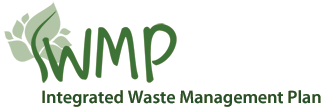1.4 IWMP planning process
The primary objective of IWMPs is to integrate and optimise waste management planning in order to maximise efficiency and minimise the associated environmental impacts and financial costs, and to improve the quality of life for all South Africans. The diagram below (figure 2) summarises the integrated waste management planning process.
Figure 2: Integrated Waste Management Planning Process
As depicted in figure 2 above, the integrated waste management planning process includes the following:
- Establishing the situation analysis which includes backlogs;
- Setting the desired end state;
- Identifying, evaluating and selecting alternative methods/approaches for achieving the desired end state;
- Implementing the integrated waste management plan; and
- Evaluating and reviewing the plan to ensure the respective objectives are being met.
As part of the IWMP development process, section 13 of the Waste Act requires the development of annual performance reports and it must be noted that this happens outside the actual IWMP development process. Section 13 (3) of the Waste Act states that annual performance report must be prepared in terms of section 46 of the Municipal Systems Act and must contain information on the implementation of the municipal IWMP, including the information set out in paragraph (a) to (j) of subsection (2) insofar as it relates to the performance of the municipality.
Main menu - nice menus
Table of contents
- Executive Summary
- List of figures
- List of boxes
- List of tables
- List of graphs
- List of acronyms
- 1. Introduction
- 2. Contents of the IWMP's
- 3. Communication and stakeholder participation
- 4. Implementation instruments
- 5. Approval process
- 6. Reporting on implementation, monitoring and review
- 7. References


